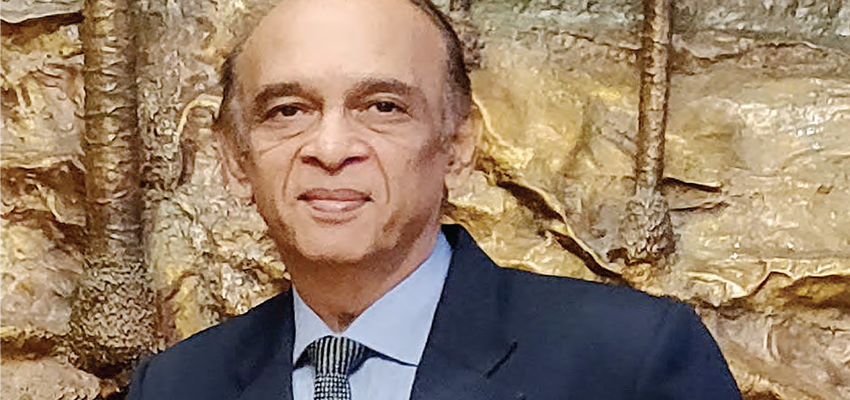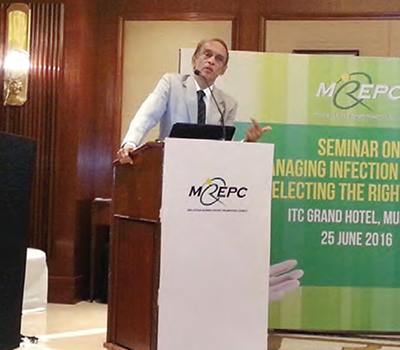Monitoring Managing Innovation

With 45 years devoted to the healthcare business, including 20 years in the rubber technologyled medical products category, Rajnikant Shah, Chairperson of Medtech Life Pvt. Ltd., transitioned into the medical devices sector in 2002. He kick-started his career with his family business in 1975, when his father renounced and adopted monkhood. He picked up business nuances, especially when they diversified into the manufacturing of electromedical products. He has since built synergies with the next generation in running the current business and adapting to the dynamic changes in the medical device sector. The thought process has been to enable affordable medical devices in a market rife with foreign products. At 74 years, age is not a barrier to learning, including his pursuit for music, as a trained singer
"Times are changing fast, and I have always believed in constant learning, be it in technology or marketing tactics, almost anything. I have always been a keen learner, and did my MBA in marketing at the age of 54 "
- Rajnikant Shah,
Chairperson, Medtech Life
 Managing manpower and medical devices
Managing manpower and medical devices
Working in the medical field for over 20 years has given us an insight that India needs access to good quality healthcare, and it can only be possible if we start making the products ourselves because back then, imported products were really expensive. That was our prime motivation,” said Rajnikant Shah, Chairperson of Medtech Life Pvt. Ltd. Medtech is the parent brand owned by Medtech Life, manufacturing homecare electro-medical devices including blood pressure monitors, nebulizers, heating pads, pulse oximeters, thermometers, steam inhalers, oxygen concentrators, including needle burners. Manufacturing 30 SKUs, it operates in the medical devices market estimated at around $6bn, in a total healthcare market estimated to be over $300bn.
An alumnus of the University Department of Chemical Technology (UDCT), Shah acknowledges his training gained during his post-graduation years at the institute. “We have been trained to work for the 21st success even after 20 failures. This attitude helped me to overcome many business-led obstacles. UDCT has one of Asia’s best libraries and the curriculum trained me to keep working repeatedly even after multiple misses just like in our chemistry labs,” he said. At 74 years, his affinity for learning continues with each passing year. “I have been learning newer nuances of business and believe that learning never stops,” he said.
Corporate Citizen captures a slice of his four decades and more in the healthcare sector, as he shares his experiences, aligning with the various changes in the medical devices sector.
Initiating the Journey
Corporate Citizen: How did you begin your journey in the healthcare sector?
Rajnikant Shah: I have predominantly worked across multiple healthcare spaces throughout my life. I initiated my career working in the rubber products category with MRK Healthcare, which expanded into the medical rubber disposables category, including surgical gloves, and syringes. I spent 20+ years in the sector, gaining vast experience of business practices. I later joined my son Yogesh Shah, a biomedical engineer, when he ventured into the medical devices category. We founded Medtech with the aim of providing high quality affordable healthcare devices.
CC: What were your learnings when the family business diversified into electro- medical products?
The transition to a new vertical induced several earnings. Traditionally, we were a B2B business which was very different from the B2C space in electromedical devices. Our biggest learning was in understanding the importance of a proper supply chain for our products. We had to work really hard and vertically integrate our organisation to establish a robust supply chain.
CC: What was the sector scenario when you co-founded the company in 2002?
We wanted every household in India to have access to good healthcare, which led us to establish a manufacturing facility in Gujarat. Co-founder, Yogesh Shah, a technology expert with medical devices helped us gain inroads into medical devices manufacturing. The scenario 20 years back prompted us to innovate affordable medical devices. Nebulizers then were sold for Rs 3000+ rupees, and we have now been able to stabilise quality medical devices including nebulizers at a substantially low cost of Rs 1200 rupees per unit.
CC: What inspired you to move on to other devices?
The success of the nebulizers showed us that Indian consumers had accepted our product. The experience drove us to develop high-quality devices at affordable rates, enabling access to good medical welfare.
CC: Do you have an international market base?
We operate across 60 countries and have formed long-term relations with our clients. Our client base extends across Asia, Europe, and the Middle-East. Since we control the manufacturing, we are able to deliver the products on time.
CC: How have you managed geographical diversities in the healthcare sector?
We initiated our journey with the objective of developing an Indian company to compete with foreign products and build accessibility across customer segments at affordable price points. We expanded gradually across India, starting with the western parts of India and working our way through the rest. Today, we are a pan-India player.
CC: How have the co-founders distributed your job responsibilities?
While I worked on the sales and marketing front, Yogesh worked on the research and manufacturing, and gradually built a strong sync between our job specs.
Manoeuvring Transitions
CC: What does being an industry veteran mean to you?
Being in the industry for over 20 years has given me deep insights into the Indian consumer. The experience is more of a responsibility to push boundaries of innovation and product development for Indians, by Indians. There is still a tremendous gap in the healthcare space which all the leaders are working towards, ushering in healthy competition. It will foster growth and progress in the industry.
"It is the trust you build with consumers that matters the most. While the product quality is of the utmost criteria, the devices are purchased based on a customer’s trust in a brand"
 Bridging the medical device through innovations
Bridging the medical device through innovations
CC: How did you manoeuvre yourself through the changing times?
Times are changing fast, and I have always believed in constant learning, be it in technology or marketing tactics, almost anything. I have always been a keen learner and did my MBA in marketing at the age of 54.
CC: How did you keep pace with the changing technology?
Our organisation is driven by innovation. We have a Department of Scientific and Industrial Research (DSIR), an approved Research and Development (R&D) division that pushes the boundaries of the products. We were the first ones to produce nebulizers, blood pressure monitors, needle burners, and oxygen concentrators at scale in India. We also conduct customer research, giving us in-depth insights into consumer requirements. The reality checks, consumer awareness, and consumer satisfaction with our products and other long-term investments have paid off in building our market.
CC: How do you classify the medical device market and your position?
The medical devices sector includes three primary categories - OTC devices, hospital equipment, and automation systems. Each category is vast, with several multiple sub-verticals. Our company is entrenched in the home healthcare devices category and focused on OTC devices. We have been diversifying across all major subcategories in this particular vertical.
CC: Are you an indigenously built, home grown brand?
Yes, we are 20 years old and a 100% Indian brand. We are a manufacturing-centric organization in a market with other foreign brands and local competitors who import their products manufactured in China. Our two decades in the healthcare devices space have earned us a nationwide presence.
CC: Who are your competitors?
There are several players in the market. Most are private label importers from China and other MNCs operating in the space.
CC: What is your market share in India’s medical device segment?
Our market share is based on our product lines and varies with each product category. Overall, it is difficult to estimate the total market share, but we have more than a 30% share in the nebulizer category.
CC: Do you have manufacturing or licensing agreements with other companies?
We have our manufacturing facilities and manufacture all our products for the Indian and international markets. We also manufacture products for our overseas clients, collaborating with several MNCs and governments to supply our products.
CC: Does the medical devices sector receive any special sops from the government?
Currently, we are awaiting some more clarity on the incentives (Budget 2023-24), which will help us evaluate the benefits of the schemes.
Sector Reach
CC: Are there any initiatives by the government to make healthcare devices available across all strata?
We regularly work in collaboration with the state and Central Government to make the devices available to government hospitals and pharmacies at affordable prices. We also route the cause via our foundation, Ashadan, helping the needy to access the devices.
CC: How have you equalised the accessibility of the devices?
We have aimed to develop more advanced devices than what is already available in the market. Our focus is on pricing, working towards building premium products at affordable prices, and adding value to our customers.
"The devices available currently in the market will soon transition into smart IOT-enabled devices and will introduce more compact devices in the future"

CC: But, what about your business margins?
We manufacture the devices on a large scale, which leads to cost reductions. It enables us to offer our consumers access to medical devices for up to 1/3rd of the price, as witnessed in the nebulizer category. They were sold for Rs 3000, 20 years back, but are now sold at around Rs 1000 per unit.
Consumer Reach
CC: What makes a medical device brand- worthy?
It is the trust you build with consumers that matters the most. While the product quality is of the utmost criteria, the devices are purchased based on a customer’s trust in a brand.
CC: Did the sector find new appeal post the Covid pandemic?
The Covid pandemic led to the widespread awareness of the importance of home healthcare and almost all devices have gained a higher appeal post the pandemic. The newer generation is more aware of preventive healthcare which has increased the visibility of medical devices.
CC: How did the pandemic impact your growth?
We have been committed to expanding our footprint even before the pandemic and, in 2018, invested in a 2 lakh sq. ft. state-of-the- art manufacturing facility in Gujarat. The pandemic led to an increased awareness of the various devices and enhanced the total addressability of the market. It led to the inflow of newer players and more customers.
CC: Did the pandemic usher in innovative strategies?
The pandemic got us thinking about investments in vertical integrations across our supply chains. We had to tackle the hurdles of low supply during the pandemic and hence, began investing in the complete end-to-end supply chain within our facilities.
CC: What has kept the sector afloat?
The total addressable market post-pandemic has increased. Constant investments in research have also brought newer and better devices regularly, keeping the market afloat.
Innovations
CC: What is the average lifecycle for medical devices in the home care segment?
The average lifecycle of a product is quite long and over 20 years. However, it is important to understand that even in the 20 years, there are product advancements that take place every year.
CC: How important are innovations in sustaining growth?
We invested in a research and development (R&D) department from day one. It has greatly paid off by developing products and technological capabilities. I believe that R&D is the reason behind our market leadership in the segment, sustaining our growth over time. We plan to continuously invest in R&D in the future as well. We have learned that our product differentiation is what gives us an edge.
CC: Is it always competition that triggers innovation?
Competition does help steer innovation. We love healthy competition, but it can still clutter the market, leaving less room to invest in R&D. We avoid dumping products or slapping extra discounts in the supply chain, as our belief is in our consumer’s reliance on our product’s quality, governing their buying intentions.
CC: Can organisations build a collective scientific temperament for enhanced R&D and product innovations?
While there is a great boost in innovation when organisations come together, it can also compromise an organisation’s intellectual property rights. We believe that if there is some radical improvement in a device, it should be available to all. When we introduced our steam inhalers, they proved to be safer than the current ones in the market and gained immediate success. We consciously decided not to patent the technology, allowing our competition to cash on from our innovation. Our objective was to enable Indian consumers to use a safer product with our new design.
Being Environment Friendly
CC: How do you sustain environmentally friendly products?
Being environmentally conscious is important, and we have been developing greener products and processes. It is a long-term commitment and will, therefore, take some time to see actionable results. We developed an LED display sphygmomanometer, eliminating the use of mercury which is hazardous when not disposed of properly.
CC: Are there any regulations in India that restrict personal medical devices from overuse?
All medical devices should be used with the guidance of a medical practitioner. Device users can safeguard themselves by opting for good quality products from reputed organisations. Brands should adhere to prescribed manufacturing standards regarding the quality and accuracy of the products. Our blood pressure monitors are clinically validated, ensuring the accuracy of the readings, and helping consumers manage their medications.
Future Transformations
CC: What transformations do you foresee in the sector?
The devices available currently in the market will soon transition into smart IOT-enabled devices and will introduce more compact devices in the future.
CC: What are your plans for the next 3-5 years?
We plan on expanding our visibility and footprint in India. India is a market that is still in its early developmental stages and is expected to mature over time. We intend to obtain more certifications for our products and expand our worldwide customer base under the ‘Made in India’ maxim.
Work-Life Balance
CC: How do you manage work-life balance?
I have been a physically active person since school and into sports for many years, which keeps me fit. At 74 years, I still follow a strict regime of waking up early, meditating, and getting some physical exercise in the gym. It has helped me remain mentally and physically in good health, helping me to derive the energy needed during work. I enjoy music to de-stress.